| The figwort, a Eurasian plant, is not well known in America, so
this family is often referred to as the snapdragon family. On the basis of
recent DNA studies, many plants previously classified as Scrophulariaceae
have been reassigned to other families. This is confusing for those who grew
up with the older classifications. Despite these changes, those plants formerly
in the snapdragon family do have common characteristics: flowers that mostly
have five petals joined for much of their length, a “lip” formed
by prominent lower petals, and four anthers (although some genera, notably
Penstemon, have a sterile fifth stamen). The family, as originally
classified, is large and included approximately 5,100 species spread throughout
the world. Its members have little economic importance other than as ornamentals
(Digitalis purpurea is an exception; not only is it a popular garden
plant, but the leaves are the source of digitalis, a potent and useful cardiac
stimulant). In order to simplify present day taxonomic matters insofar as
possible, we have elected to leave plants previously classified as
Scrophulariaceae under that heading, and include the newer—now generally
accepted—classifications as subheadings. For our plants, these
include:
(1) Orobanchaceae, the broomrape family includes: paintbrushes
(Castilleja), broomrapes (Orobanche), owl-clovers
(Orthocarpus), and louseworts (Pedicularis).
(2) Phrymaceae (lop-seed family) includes the monkeyflowers
(Mimulus spp.)
(3) Plantaginaceae * (plantain family) includes Penstemon,
Collinsia, Veronica, Synthyris (kitten-tails), Chionophila
(snowlovers), Limosella (mudworts), and Linaria
(toadflaxes).
(4) Scrophulariaceae: Only one local plant, Verbascum thapsus
(the common, Eurasian roadside mullein) is in this family as it is now
is classified.
* Note: Some botanists believe that various genera, including Veronica
and Synthiris in the Plantaginaceae family should be moved
to yet another new family, the Veronicaceae. |
 |
Western naked broomrape, Orobanche
uniflora L. var. occidentalis R. L. Taylor
& MacBryde (left, right) is a non-chlorophyllaceous
plant that grows throughout North America. It is a parasite whose modified
root system invades the roots of neighboring plants—in Idaho that means
sagebrush. Lack of chlorophyll results in a yellowish-brown to purple coloration
(the latter more noticeable at higher elevations, right).The plant’s
relationship to other hemi-parasitic Scrophulariaceae (Castilleja,
Orthocarpus, Pedicularis, etc.) has long been noted; these genera are
now also in the broomrape family. The “rape” in
“broomrape” was derived from a Latin word, rapum, meaning
“knob” referring to lumps that form on the roots of brooms (shrubs
in the pea family), caused by a European broomrape. Orobanche, in
turn, was derived from two Greek words and means, approximately,
“vetch-strangler.” |
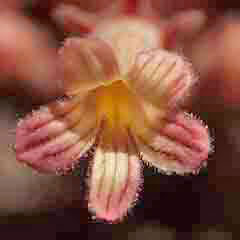 |
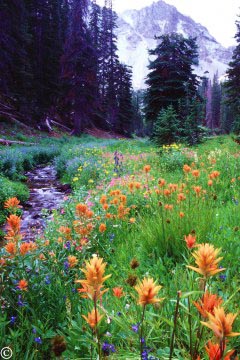 |
Indian Paintbrushes, Castilleja
spp.:
Castilleja
species were named for Domingo Castilleja,
(1744-1793), an early Spanish botanist. Only one species is common in the
eastern United States, but there are about 250 species in the West, about
forty in the Pacific Northwest and of these a dozen or more occur in our
mountains. Classification can be difficult. Look closely among the colorful
terminal bracts and you’ll see a slim yellow flower made up of a four-spiked
calyx from which five petals protrude (right). While hard to make out, the
two lower petals form a characteristic "lip"; there are two tiny lateral
ones; and then an overhanging beaklike fifth petal known as a
“galea,”
Scarlet paintbrush, Castilleja
miniata, Douglas ex Hook. (
left, righ) is the most common paintbrush in Idaho, growing at all elevations
to well above tree-line. The red bracts (upper leaves) each have two small
lateral projections—an identifying feature. David Douglas first collected
the plant in Oregon’s Blue Mountains. |
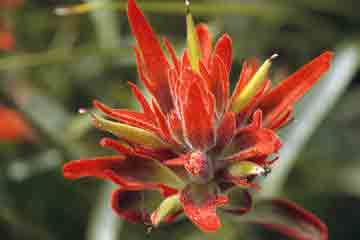 |
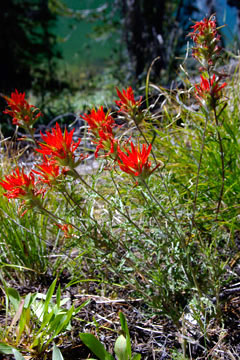 |
Wavy-leaf Indian paintbrush, Castilleja
applegatei Fern. (left, right)
might easily be confused with the scarlet paintbrush ,shown above. This far
less common plant may be distinguished by its crisped (or wavy-edged) leaves.
The wavy-leaf paintbrush grows, as one or another variety, in all of the
western states save Washington. Several varieties are recognized--we are
uncertain which one this is. |
 |
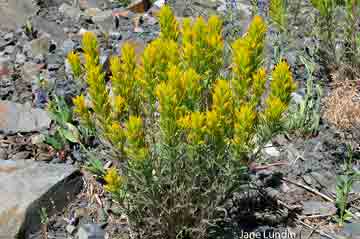 |
Yellow paintbrush, Castilleja
flava S. Watson
(left) is characterized by its bright yellow bracts. These
typically have two long lower lobes and three short terminal lobes. The yellow
paintbrush occurs from foothills to fairly high in the mountains of the southern
and south-central parts of the state. It is also found in bordering parts
of adjacent states to the east and south.
|
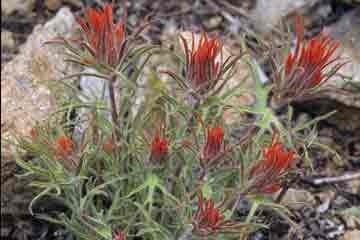 |
Rocky Mountain paintbrush, Castilleja
covilleana L. F. Hend.
(leftt) is a localized plant found in central Idaho and,
unusually, in adjacent Montana. Within its limited range, it is not uncommon.
The plant is not hard to identify, given its elongated, spidery, three lobed
leaves and bright red, orange, or occasionally yellow bracts. It is one of
our earliest blooming paintbrushes, at home on rocky, sagebrush covered slopes.
The plant’s species name honors a prominent botanist, Frederick Vernon
Coville (1867-1937), curator of the U.S. National Herbarium and chief botanist
of the USDA.
Cusick’s paintbrush, Castilleja
cusickii Greenm. (right) is a common montane
to alpine plant in Idaho, the surrounding states and British Columbia. The
plant’s attractive bright yellow bracts, its preference for the mucky
ground of moist meadows, and its tendency to grow in discrete clusters should
be sufficient to identify the plant when first seen. |
 |
 |
Rosy Indian paintbrush, Castilleja
rhexifolia
Rydb. (left), may be identified by its dark-red bracts
and by lanceolate leaves that lack projecting lobes. While not uncommon,
the rosy paintbrush is seen less often than the scarlet paintbrush shown
above. .It is usually found in fairly moist situations. The species name,
rhexifolia, links the shape of its leaves to those of rhexias, plants
found mostly in the southern and eastern states
Castilleja angustifolia
(right)
|
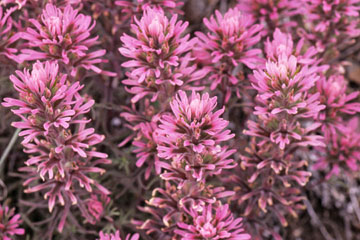 |
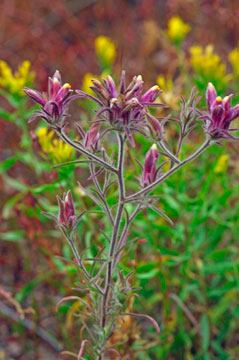 |
Yakima birdbeak, Cordylanthus
capitatum Nutt. ex Benth.
(left). While the birdbeaks are also in the broom-rape
family, they are not as well known as their showier cousins, the Indian
paintbrushs. Nevertheless the birdbeaks will be recognized by their similarity
to the latter. The Yakima birdbeak is a moderately tall, rather inconspicuous,
straggly plant characterized by overall hairiness and the dark color of its
stems, foliage and flowers. The latter resemble those of paintbrushes in
that the flowers are surrounded by paintbrush-like bracts. The lowest leaves
on the main stem often have two thin lateral lobes in common with many
paintbrushes. Our birdbeak is a mid-elevation foothill and mountain
plant that appears in early- to mid-summer on dry ground in sagebrush
communities. As with other Orobanchaceae, it is a hemi-parasitic plant. Two
species of Cordylanthus grow in Idaho. The one shown here grows in
the other three northwestern states and, rarely, in California. |
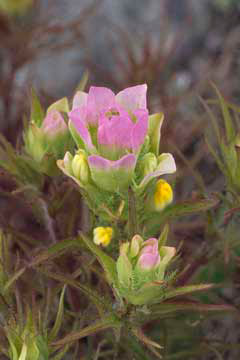 |
Thin-leaf owl-clover, Orthocarpus
tenuifolius (Pursh) Benth.
(left). Owl-clovers (also “owl’s clover”)
are closely related to Indian paintbrushes—at one time they were included
in the same genus. Most owl-clovers are not particularly attractive, but
this one with its delicate yellow and light purple bracts is an exception.
It is a montane to alpine plant found in the northern part of Idaho. Meriwether
Lewis collected this plant on July 1, 1806, while camped at
“Traveler’s Rest” in the Bitterroot Valley near today’s
Missoula, Montana. Orthocarpus means “straight fruit,” referring
to the shape of the seed capsule; tenuifolia means “thin
leaf”—the plant’s common name. The origin of the term
“owl-clover” is obscure.
|
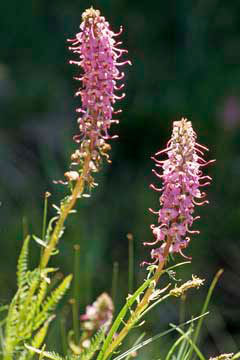 |
Elephant-head, Pedicularis
groenlandica
Retz. (left, right). Bizarre little flowers are borne
in a tightly packed spike above feather-like leaves. The flowers have a hooded
upper petal, (“galea”) with a long projection that resembles an
elephant’s head and trunk. A three lobed lower lip forms the face.
It is a common montane to alpine plant that grows on moist ground from
late spring into the summer. Its appearance is so distinctive that the plant
is easily recognized. Louseworts, like other Orobanchaceae are parasites
that depend on other plants. Pedicularis is a Latin word meaning
“lousy”; in former times it was believed that sheep browsing the
European lousewort, Pedicularis sylvatica L., were infested with lice
from the plant. Meriwether Lewis collected the Greenland lousewort
on July 6, 1806, on the Blackfoot River, upstream from today’s Missoula,
Montana.
|
 |
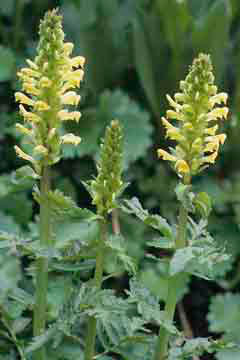 |
Yellow-flowered bracted lousewort, Pedicularis
bracteosa Benth. (left) grows in moist places,
at high elevations. The species name, bracteosa, is derived from small
toothed leaves (bracts) that are below each flower. The plants have fernlike
leaves, common to the genus Pedicularis. Seven varieties of bracted
lousewort are recognized.
White sickletop lousewort, Pedicularis
racemosa Douglas ex Benth. (right).The sickletop
lousewort (also parrot’s beak lousewort) is another Pedicularis
species that grows in our high mountain meadows. The plant shown here, var.
alba, is white-flowered, common to Idaho, although a pink to purple
variety, var. racemosa, grows further to the west. One will have no
problem identifying either variety, for the galea (a modified upper petal)
is sharply hooked into the sickle shape responsible for its common names.
The species name, racemosa, is a description of how the flowers are
clustered, botanically as a “raceme.” |
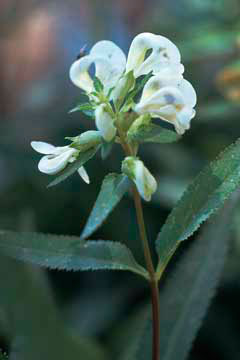 |
















